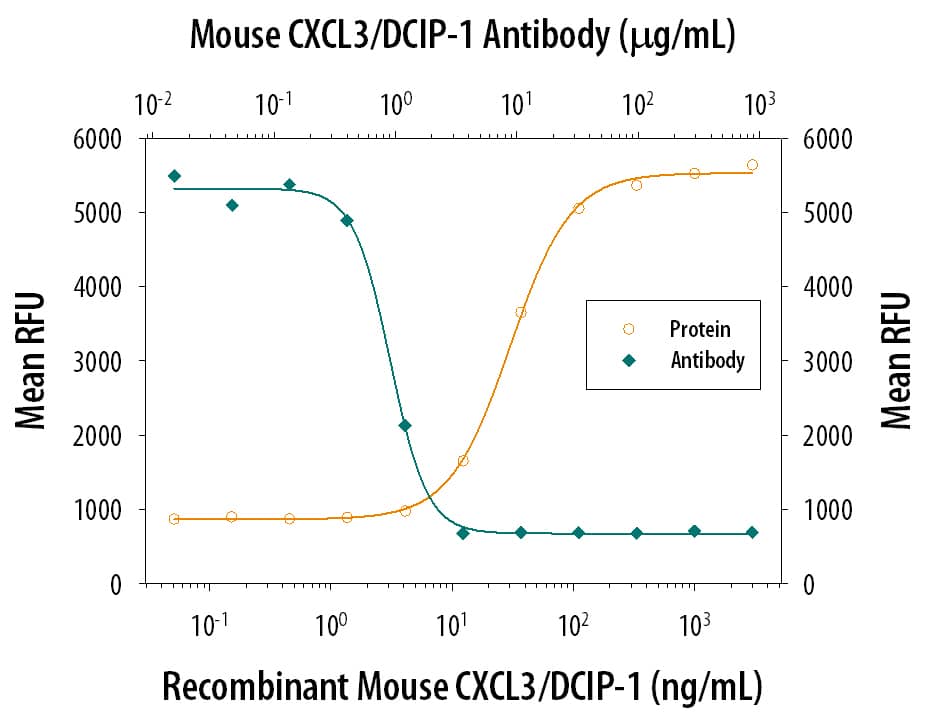Mouse CXCL3/GRO gamma/CINC-2/DCIP-1 Antibody
R&D Systems, part of Bio-Techne | Catalog # AF5568

Key Product Details
Species Reactivity
Validated:
Cited:
Applications
Validated:
Cited:
Label
Antibody Source
Product Specifications
Immunogen
Ala28-Ser100
Accession # AAI17017
Specificity
Clonality
Host
Isotype
Endotoxin Level
Scientific Data Images for Mouse CXCL3/GRO gamma/CINC-2/DCIP-1 Antibody
Chemotaxis Induced by CXCL3/DCIP‑1 and Neutral-ization by Mouse CXCL3/ DCIP‑1 Antibody.
Recombinant Mouse CXCL3/DCIP-1 (Catalog # 5568-CA) chemo-attracts the BaF3 mouse pro-B cell line transfected with human CXCR2 in a dose-dependent manner (orange line). The amount of cells that migrated through to the lower chemotaxis chamber was measured by Resazurin (Catalog # AR002). Chemotaxis elicited by Recombinant Mouse CXCL3/ DCIP-1 (100 ng/mL) is neutralized (green line) by increasing concentrations of Sheep Anti-Mouse CXCL3/ DCIP-1 Antigen Affinity-purified Polyclonal Antibody (Catalog # AF5568). The ND50 is typically 0.5-3 µg/mL.Applications for Mouse CXCL3/GRO gamma/CINC-2/DCIP-1 Antibody
Western Blot
Sample: Recombinant Mouse CXCL3/DCIP-1 (Catalog # 5568-CA)
Neutralization
Reviewed Applications
Read 1 review rated 2 using AF5568 in the following applications:
Formulation, Preparation, and Storage
Purification
Reconstitution
Formulation
Shipping
Stability & Storage
- 12 months from date of receipt, -20 to -70 °C as supplied.
- 1 month, 2 to 8 °C under sterile conditions after reconstitution.
- 6 months, -20 to -70 °C under sterile conditions after reconstitution.
Background: CXCL3/GRO gamma/CINC-2/DCIP-1
CXCL3 is also known as MIP-2 beta (macrophage inflammatory protein 2 beta), or DCIP-1 (dendritic cell inflammatory protein-1) in mouse, CINC2 (cytokine-induced neutrophil attractant 2) in rat, and GRO-gamma (growth-regulated oncogene gamma) in humans (1, 2). It is an 8 kDa proinflammatory member of the CXC subfamily of heparin-binding chemokines, also called alpha chemokines (1‑4). The Glu-Leu-Arg (ELR) motif near the CXCL3 N-terminus confers angiogenic properties and distinguishes it from interferon-inducible ELR- CXC chemokines, which are angiostatic (4). ELR+ and ELR- chemokines use CXCR2 and CXCR3 receptors, respectively (3, 4). Mature mouse CXCL3 shares 88% and 57% amino acid (aa) sequence identity with rat and human CXCL3, respectively. Among mouse ELR+ chemokines, it shares 82% aa sequence identity with CXCL2/GRO-beta /MIP-2 and 34% - 58% with CXCL1/GRO-alpha /KC, CXCL5/ENA-78 and CXCL7/NAP-2. Due to their similar sequence and activity, CXCL2 and CXCL3 are sometimes referred to collectively as CXCL2/3, but are separate gene products (4‑6). Mouse CXCL3 expression is induced in macrophages and early in maturation of DC by bacterial products such as lipopolysaccharides, and other inflammatory mediators (1, 7). It is chemotactic for CXCR2‑expressing neutrophils, helping to recruit them to areas of inflammation (1, 7). ELR+ chemokines also elicit endothelial cell chemotaxis, stimulating angiogenesis and playing a role in tumor development (3, 4). ELR+ chemokines upregulated by ischemia play a role in ischemia-reperfusion injury (5, 6). A decoy receptor, DARC (Duffy antigen receptor for chemokines) competes with CXCR2 for ELR+ chemokine binding, thus downregulating their effect (8). Neutrophil influx may also be downregulated by MMP-12, which has been found to inactivate CXCL3 and other ELR+ chemokines by cleaving them at the ELR site (9). Over aa 28-100, mouse CXCL3 shares 87.8% aa identity with rat CINC2.
References
- Nolan, K. F. et al. (2004) J. Immunol. 172:2201.
- Modi, W. S. and T. Yoshimura (1999) Mol. Biol. Evol. 16:180.
- Vandercappellen, J. et al. (2008) Cancer Lett. 267:226.
- Strieter, R.M. et al. (2005) Cytokine Growth Factor Rev. 16:593.
- Nesmelova, I. V. et al. (2008) J. Biol. Chem. 283:24155.
- Maheshwari, A. et al. (2004) Fetal Pediatr. Pathol. 23:145.
- Furuichi, K. et al. (2008) Front. Biosci. 13:4021.
- Takano, K. and H. Nakagawa (2001) Inflamm. Res. 50:503.
- Horton, L. W. et al. (2007) Cancer Res. 67:9791.
Alternate Names
Gene Symbol
UniProt
Additional CXCL3/GRO gamma/CINC-2/DCIP-1 Products
Product Documents for Mouse CXCL3/GRO gamma/CINC-2/DCIP-1 Antibody
Product Specific Notices for Mouse CXCL3/GRO gamma/CINC-2/DCIP-1 Antibody
For research use only
